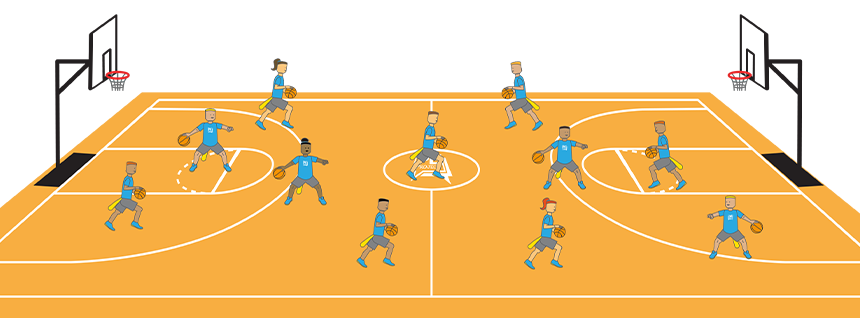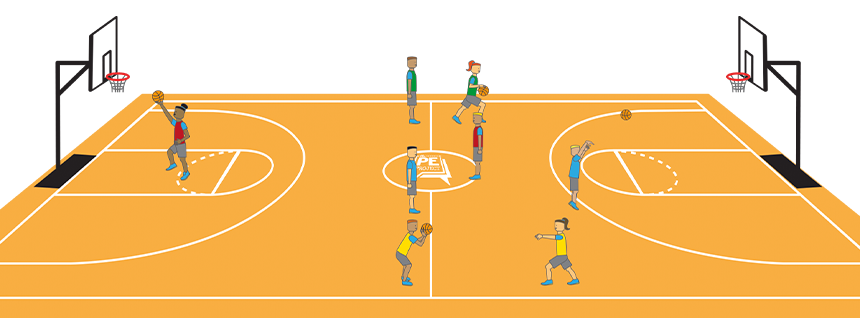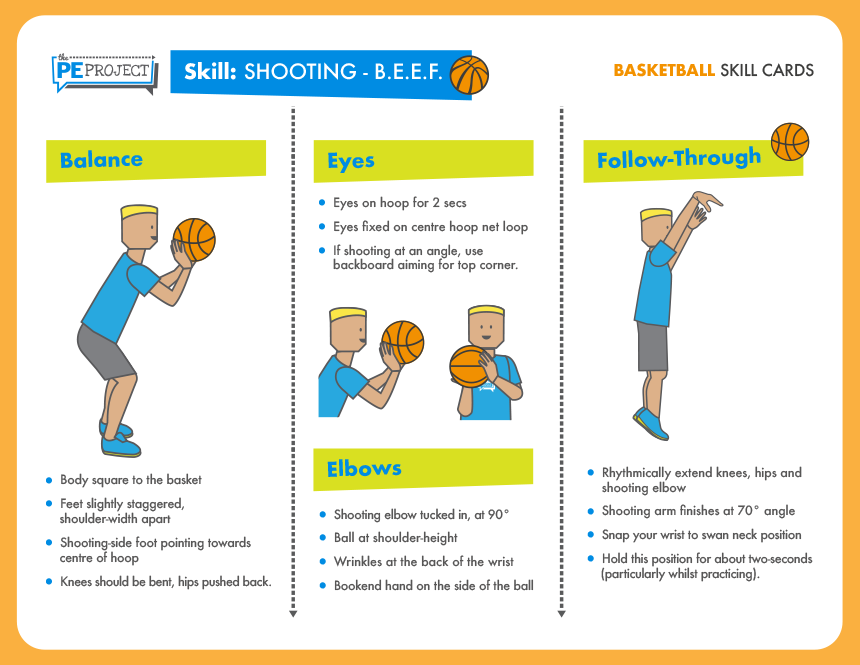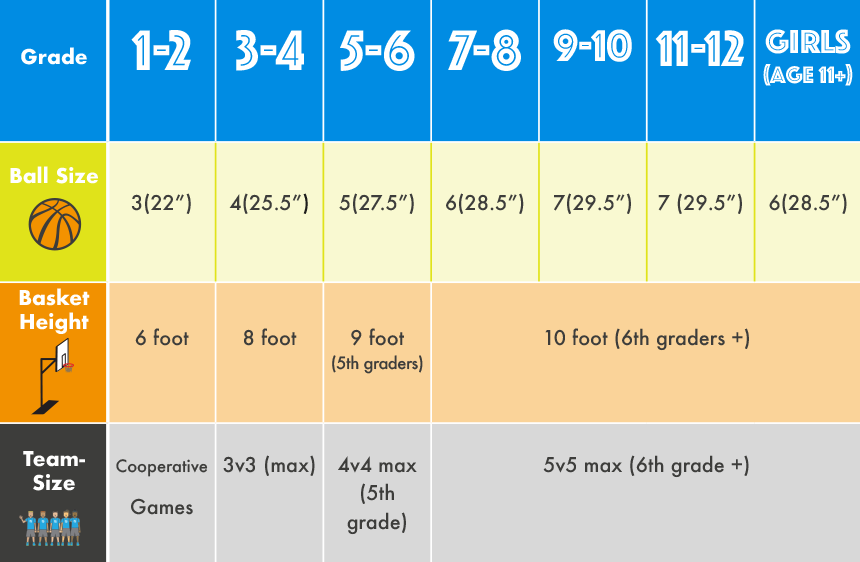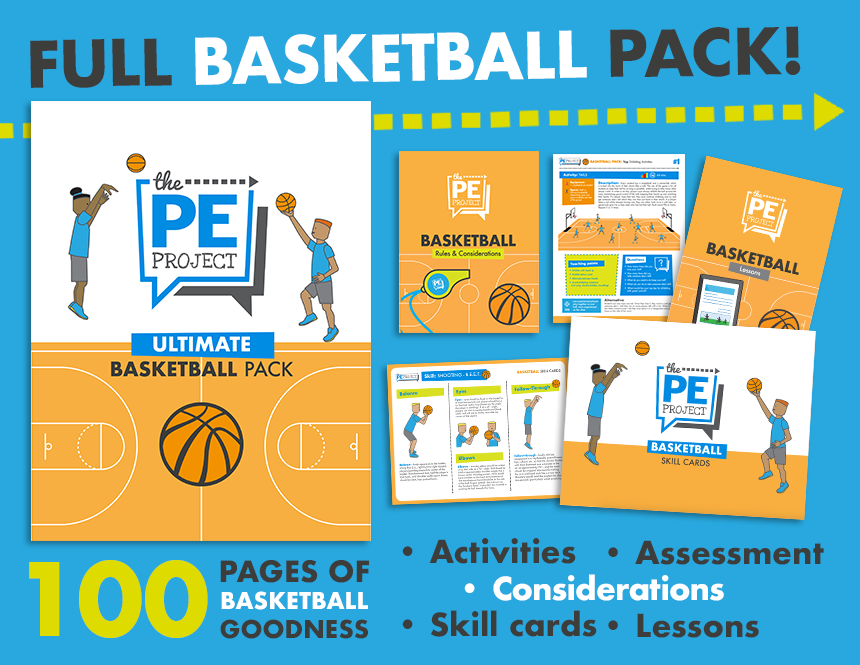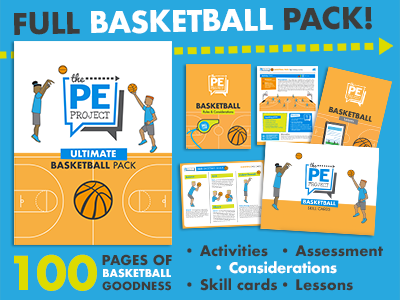When teaching basketball in Physical Education lessons, it is helpful to have a range of activities, teaching models and styles in the toolbox to help ensure students make great progress. Basketball lessons can be delivered in a range of ways depending upon the age, group size, resources available and your level of knowledge of the game.
If teaching lower Elementary (Primary/KS1) you may want to opt for more cooperative group activities where students can explore the different skills without the pressures of any defenders. Then in upper Elementary (Primary/KS2) students can experience a range of competitive, cooperative, and small-sided games (3v3). Once students move into Middle-School (KS3) and High-School (KS4 & 5) this is where students can begin to experience the full-scale versions of the game through 5-on-5 games. A great way to do this would be using a ‘Teaching Games for Understanding’ model.
Below are a few basketball activities, an example skill card and lesson plan from our ‘Ultimate Basketball Pack’ that you can use in your lessons.
Description: Every student has a basketball and a pinnie/bib which is tucked into the back of their shorts (like a tail). The aim of the game is for all students to keep their tail for as long as possible, whilst trying to take away other player’s tails. In order to do this, players must always dribble the ball around the area, maintaining good control of the ball, keeping their heads up and watching their backs. If a player loses their tail, they must continue dribbling and try and get someone else’s tail which they can then put back in their shorts. If a player takes a tail whilst already having one, they can either hold on to it until later, or generously give it to a class mate who has lost their tail. Each round 90s to 2mins. Repeat 2 or 3 times.
Alternative: Students can only have one tail. Once they lose it, they must try and get someone else’s, until their are no more players left with a tail. When a player has taken someone else’s tail they must place it in a designated area e.g., hulahoop on the side of the court.
Teaching Points
- Dribble with head up
- Dribble below waist
- Alternate between hands
- Avoid dribbling violations (carrying, double-dribble, travelling)
Questions
- How many times did you lose your tail?
- How many times did you take someone else’s tail?
- What do you need to do keep your tail?
- What can you do to take someone else’s tail?
- What would be your top tips for dribbling with great control?
Description: Every student has a basketball and a pinnie/bib which is tucked into the back of their shorts (like a tail). The aim of the game is for all students to keep their tail for as long as possible, whilst trying to take away other player’s tails. In order to do this, players must always dribble the ball around the area, maintaining good control of the ball, keeping their heads up and watching their backs. If a player loses their tail, they must continue dribbling and try and get someone else’s tail which they can then put back in their shorts. If a player takes a tail whilst already having one, they can either hold on to it until later, or generously give it to a class mate who has lost their tail. Each round 90s to 2mins. Repeat 2 or 3 times.
Alternative: Students can only have one tail. Once they lose it, they must try and get someone else’s, until their are no more players left with a tail. When a player has taken someone else’s tail they must place it in a designated area e.g., hulahoop on the side of the court.
Teaching Points
- Dribble with head up
- Dribble below waist
- Alternate between hands
- Avoid dribbling violations (carrying, double-dribble, travelling)
Questions
- How many times did you lose your tail?
- How many times did you take someone else’s tail?
- What do you need to do keep your tail?
- What can you do to take someone else’s tail?
- What would be your top tips for dribbling with great control?
Skill Cards: When teaching basketball it can be extremely useful for students to use skill cards to deepen their understanding of complex skills. For example, when trying to teach students how to shoot in basketball with correct technique, they could use the above skill card to read over with a partner. After, they will then take turns practicing shooting whilst their partner observes and gives feedback. This is an example of a 'Reciprocal Teaching Style' which you can learn more about in our 'Teaching Styles' article.
Teaching Considerations: When teaching any activity to children it is important to consider: What grade are they in? What size ball should they use? How high should the basketball be? and; What sized teams should they play in? We hope that the above table will help you answer those questions quickly and confidently. If you don't have the luxury of having an adjustable basketball hoop, simply hang a hula hoop over the rim and students can shoot for that instead or as well i.e., 1 point for the hula hoop, 2 points for getting the ball in the basket.
Example Basketball Lesson
Lesson Objectives
- Explore and improve understanding of the rules in basketball
- To be able describe and/or demonstrate triple-threat, pivoting and dribbling in basketball
- To apply these skills into games
Students have 2-minutes to discuss as many rules of basketball that they currently know. Students should be sitting on the floor, facing each other showing good listening and communication skills sharing their knowledge of basketball rules. After, have each group share one rule with the class. Try it differently - give students a large piece of paper and pens and they have to write down the rules they know with a brief description.
Students play a 3-on-3 basketball, demonstrating their understanding of the rules of the game. Students are expected to call their own violations to demonstrate their understanding. During this game, the teacher can float between the groups, stopping games where necessary to clarify any basic rules.
Formative Assessment: This is a good opportunity to assess students understanding of the game, and their ability.
Questions
Did you manage to play your games fairly? Call your own violations? Agree on calls? Any rules that you are unsure about?
The teacher has 4 cones in their hand which they will hold up at different times during the activity. Red = Stop (hold the ball in the triple threat position); Green = Go (dribble into space, avoiding other players); Orange = Change direction (players perform crossovers and change direction without picking up the ball); Blue = Fancy tricks (students show off their basketball dribbling skills they have).
Teaching should be constantly walking around the area, encouraging students to keep their head up. When holding up a red cone (students in triple-threat), encourage players to pivot so that they are always square to the teacher. Drip feed in different coaching tips (▼ see Skill Cards p.2).
Questions
Did you manage to play your games fairly? Call your own violations? Agree on calls? Any rules that you are unsure about?
Students have to dribble around the area protecting their ball whilst also knocking away other players basketballs. The challenge - how many other people’s basketballs can you knock away in 2 minutes. Teacher to encourage players to keep their head up, dribble below their waist, find space, practice dribbling with both hands (not at the same time).
Questions
How do you keep control of the ball? When do you think you use triple-threat? How can pivoting help you in a game?
Students return to playing 3-on-3 basketball against a different team. During this game the teacher will focus on encouraging and recognising players that are demonstrating triple-threat, pivoting, and dribbling. Students continue to officiate their own games.
Assessment: Assess students triple threat, footwork and dribbling.
Plenary
In groups of 3-5, students to discuss 1) What is Triplethreat; 2) How to Pivot; 3) How to dribble; 4) Which of these skills they felt they are best at? What do they need to do to improve? Teacher circulates the groups, listening in to the different conversations.
The Ultimate Basketball Pack
Would you like more basketball activities? Download the Ultimate Basketball Pack with over 50 basketball activities that are appropriate for using in PE lessons. Our pack will help you deliver high-quality basketball lessons for Phys Ed! It has been developed by highly-qualified and experienced PE teachers for specialists and non-specialists alike who want to deliver the best basketball lessons where students can make exceptional progress.
In the Ultimate Basketball Pack by the PE Project you will find:
- Over 50 basketball activities
- Skill Cards
- Lesson Plans
- Assessment Criteria for Elementary, Middle-School, and High-School
- Basketball Rules
- Non-doer sheets
- Plus lots of additional extras like questions, teaching recommendations, differentiation strategies.


